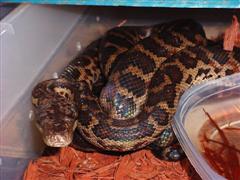Boa - Haitian
Scientific Name: Epicrates striatus striatus
Mon, 28th April, 2025 - 8:30 am GMT
Sponsor Ads:

Alternative Name
Scientific Name: Epicrates striatus striatusBasic Info
Averaging between six and seven feet, the Haitian Boa is a large snake. Some specimens have been recorded at nine feet or more. They have slender, agile bodies that are well suited for climbing trees. Their skin is usually tan or gray with dark brown blotches that are often edged in black. The blotches are sometimes in a chain pattern. The head exhibits a dark line directly behind the eye.
Health
Haitian Boas are large snakes that require a large, tall enclosure. They should be provided with branches to climb on. Temperature and humidity levels should tropical. Juveniles are notoriously difficult to feed in captivity. Some hobbyists suggest raising humidity in order to promote feeding. Breeding While Haitian Boas have been bred in captivity, it is not common. Mating is more likely when more than one male is present. The snakes mate in winter and early spring. Haitian Boas give birth to live young, usually about six months after mating. They usually have around 15 babies, but some have upwards of around 40. Still births and infertility are common problems. Feeding the captive offspring is usually the biggest challenge as they will only eat small lizards.Habitat
Lives in damp, wooded regionsBehavior
The Haitian Boa is a fairly large snake native to the West Indies. While wild-caught specimens are usually moderately aggressive, they can become quite docile with regular handling. Unfortunately, it is difficult to feed young captive born Haitian Boas and, as a result, they are not commonly available. The Haitian Boa usually lives in damp, wooded regions. They are nocturnal, meaning they are active at night. During the daytime, they rarely move and when they do, they move very slowly. They are primarily arboreal, spending most of their time in trees. Haitian Boas will, when frightened, emit a foul smelling musk from their anal glands. While wild-caught Haitian Boas are usually somewhat aggressive and nervous when first caught, they can become quite docile once they are accustomed to their surroundings and used to being handled.Origin
CaribbeanHistory
The Haitian Boa is found on the island of Hispaniola in the West Indies. It is a subspecies of the Bahama Boa, which also includes snakes from Cat Island, Ragged Islands, Margaret Cay, Andros and the Berry Islands.Common Foods
Mature Haitian Boas feed primarily on rodents and birds. The juvenile snakes feed only on small lizards.Sponsor Ads:
Weinberg's Law: If builders built buildings the way programmers wrote programs, then the first woodpecker that came along would destroy civilization.
Boa - Haitian
Coded by: BGID® | ALL RIGHTS RESERVED Copyright © 2000-2025
Disclaimer | Privacy | Report Errors / Contact | Credits








 Preparing For China. China is growing their military. China Military Technology - can it keep up with the US?
Preparing For China. China is growing their military. China Military Technology - can it keep up with the US?  versus
versus 

 versus
versus 
 This Thread is about the North Korean Military itself - the kind of army, navy, and air force they have.
This Thread is about the North Korean Military itself - the kind of army, navy, and air force they have. 
 versus
versus 
 versus
versus  versus
versus